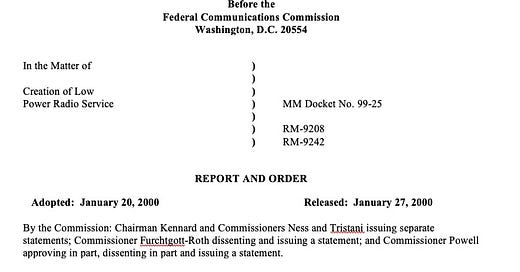Marking 25 years of LPFM
A look back at the movement for community media, and why it still matters
Back in the 1990s, media watchers doubted that community media champions would prevail at the Federal Communications Commission. Money and political influence had already transformed federal law-making. Instead of occasional, high-level reviews of federal agencies, Congress members had become micromanagers. The Media Access Project and other advocates also faced a crowded radio market and powerful opponents. The National Association of Broadcasters opposed low-power FM. And, surprisingly, so did the Corporation for Public Broadcasting.
Yet, on January 20, 2000, the FCC voted 3-2 (ish) to create low-power radio service.
Here’s the original press release with highlights of the new order and report.
The work to reduce those barriers-to-entry in community media, including by allowing low-power broadcasting, began decades earlier. Congress created the noncommercial educational license class as it created the FCC. At first, the NCEs - Non-Commercial Educational stations, as they are still known, broadcast on the AM band. They moved to FM in 1940. After World War II, just 38 of 918 radio licenses were NCEs. To address that gap, the FCC authorized an experiment with low-power FM in upstate New York in 1947. The broadcast partnership between Syracuse University and General Electric was successful. The radio station grew from low-power FM to a full-power, NPR affiliate serving central New York, WAER.
The FCC followed that success by creating the Class D license for low-power broadcasting. Still, few stations replicated WAER’s path. In a research paper tracing the history of low-power broadcasting, Alan Stavitsky, Robert Avery, and Helena Vanhala noted the common example in a college radio station from 1972. The station operated with a $1,000 annual budget and trouble-shooting from a community volunteer. Class D stations were often called ‘electronic sandboxes,’ leaving them vulnerable to the criticism that they were taking up valuable space on the spectrum while serving few listeners.
The Stavisky, et al., paper was published about 18 months after the FCC established LPFM. It would take the agency 13 more years to issue licenses, and 10 more years to open the license window again.
Nearly 25 years ago, the authors had this to say about the future of low-power broadcasting:
If low-power radio does survive the vagaries of legislation, the experience of Class D suggests that today’s new low-power voices will be under intense scrutiny to provide a compelling service at a time when public as well as commercial broadcasters vehemently challenge their existence. In a telecommunication policy environment dominated by the tenets of corporate liberalism, a smattering of listeners may not prove to be adequate justification for preserving an allocation of precious spectrum. Given the realities of the electronic media marketplace and the lessons of Class D, it’s difficult to be optimistic about the prospects for a dynamic low-power FM service . . .
These external threats remain (although, notably, these days the National Association of Broadcasters [NAB] and the Corporation for Public Broadcasting [CPB] are looking for allies in a hostile political climate). Some advocates point, instead, to threats from within.
Back in 2011, Prometheus radio surveyed 144 low-power stations and found a large portion were broadcasting religious messages (n=40) or religious music (n=54). Religious broadcasters claim they are being left out of broadcast opportunities, yet they often pay cash for frequencies and gobble up former community stations. Still other religious groups seem to view LPFM as a way to develop questionable “franchising” of religious broadcasting.
Meanwhile, this faith leader argues that the secular public media is a treasure.
Commercial interests are also horning into LPFM, which, by rule, is prohibited from airing commercials. Here’s a sound check on WZPP, which was recently fined by the FCC for boosting its signal beyond its license. (Tip-of-the-hat to RecNet.)
You can find more information about low-power broadcasting worldwide here.
This FCC Actions Alert is produced by the volunteers at the Community Media Assistance Project under the direction of CMAP Executive Director, Betty McArdle. We monitor many sources of information about the Federal Communications Commission, federal communications law, and community developments important to your station and your community. The information provided in this newsletter is for general informational purposes only and should not be considered as financial or legal advice. Always consult with a qualified professional before making any decisions based on the content herein. If you have a news tip, please email us at betty@c-map.org.
Communications Act of 1934, Sect. 326.
Nothing in this Act shall be understood or construed to give the Commission the power of censorship over the radio communications or signals transmitted by any radio station, and no regulation or condition shall be promulgated or fixed by the Commission which shall interfere with the right of free speech by means of radio communication.




